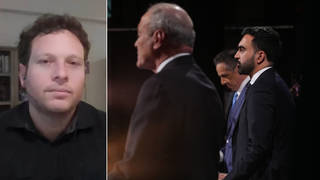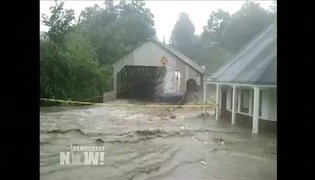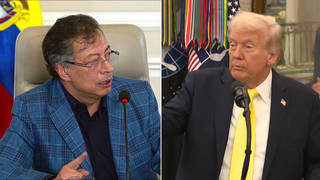
Guests
- Peter ShumlinGovernor of Vermont.
Emergency officials say at least 22 people across eight states may have died as a result of Hurricane Irene, which spanned more than 500 miles at some points. After making landfall in North Carolina on Saturday, the hurricane was downgraded first to a tropical storm and then to a post-tropical cyclone as it hit New York City, flooding waterfronts and low-lying areas. Up to four million customers from North Carolina to Maine remain without electricity. Authorities say it could take more than a week to restore all of the power. Meanwhile, in Vermont, Tropical Storm Irene dropped heavy rains late on Sunday, causing flash floods, forcing hundreds of evacuations, and leaving 40,000 to 50,000 people without power. It is becoming the state’s worst natural disaster since the Great Flood of 1927. Vermont Gov. Peter Shumlin joins us for an update from Vermont, where nearly every community is surrounded by hills and valleys, with small streams feeding into rivers. Shumlin notes that since he was sworn into office seven months ago, “this is the second major disaster as a result of storms. We had storms this spring that flooded our downtowns and put us through many of the same exercises that we’re going through right now. We didn’t used to get weather patterns like this in Vermont. The point is, we in the colder states are going to see the results of climate change first.” [includes rush transcript]
Transcript
AMY GOODMAN: Emergency officials say at least 22 people have died across eight states as a result of Hurricane Irene. The large storm spanned more than 500 miles. After making landfall in North Carolina Saturday, Hurricane Irene was downgraded first to a tropical storm, then to a post-tropical cyclone as it hit New York City, flooding waterfronts and low-lying areas. Up to four million people from North Carolina to Maine remain without electricity. Authorities say it could take more than a week to restore all the power.
Meanwhile, in Vermont, Tropical Storm Irene dropped heavy rains late on Sunday, causing flash floods, forcing hundreds of evacuations, leaving 40,000 to 50,000 people without power. It’s becoming Vermont’s worst natural disaster since the Great Flood of 1927. At least one person has died in the storm. Hundreds of roads statewide are closed. Thousands of homes and businesses suffered serious damage from flooding. Authorities insist the Vermont Yankee power plant near Brattleboro is safe. Vermont Governor Peter Shumlin says the flooding in Windham and Bennington counties is, quote, “catastrophic.”
We turn right now to Governor Shumlin, who’s about to board the helicopter to view the damage. We thank you so much for joining us right now. Tell us what has happened to your state, to Vermont, Governor Shumlin.
GOV. PETER SHUMLIN: Well, first, thanks so much for having me on. You know, we’ve just been devastated. We prepared for the worst. And frankly, we got the worst, just extraordinary amounts of rain, as much as an inch and a half an hour. And in this little state, which is nothing but beautiful mountains feeding into valleys with small streams, that just means flooding, loss of property, houses, bridges, infrastructure. So we’ve been devastated, particularly in the southern and central parts of Vermont.
AMY GOODMAN: Explain exactly how the hurricane, which was downgraded to a tropical storm, a cyclone, hit Vermont. What were your expectations before?
GOV. PETER SHUMLIN: Well, we prepared for the worst, so we were expecting both high winds and lots of water. We didn’t get the high winds, we did get tons of water, more than we can absorb. So what that means is that—you know, take the little town where I was born, Brattleboro, Vermont, little, teeny Whetstone Brook, that anyone that goes to that part of town, downtown, has been through, because it borders the Latchis Theater, our Brattleboro Food Co-op and the rest. That little, teeny river as an example, a little brook, really, just is a raging waterway. It’s eaten away at buildings that have been there for 150 years. Some of them probably will not survive. So, if you magnify through every small community in Vermont, that’s where we are. We have lots of people without power. We have, obviously, road and bridge infrastructure challenges. As you mentioned, we did have one tragic loss of life. A young girl up in Wilmington was swept away by the Deerfield River. So we’re just simply trying to assess and get folks back on their feet. But it’s a real challenge for us up in the Green Mountain State.
AMY GOODMAN: Can you talk about the nuclear power plant, something you’ve been trying to take offline for quite a time now, Governor Shumlin? Where is it? Brattleboro is so hard hit, right near there. Vermont Yankee, what—what can we expect? What are you doing now about it?
GOV. PETER SHUMLIN: Well, you know, that’s an old, aging, leaking plant, run by a company that can’t seem to tell the truth. But in this particular case, the storm should not have impacted Vermont Yankee. It’s far enough from the Connecticut River so that, you know, there isn’t extensive flooding right there. It tends to be our small downtowns, houses, downtown buildings that were built, you know, 200 years ago, that are being hit the hardest. They were built next to rivers, because that’s how we got our power in those years, through, you know, dams and other hydro projects. So we’re really feeling it in our downtowns, as well as small rural communities across the state.
AMY GOODMAN: Should the power plant be shut down right now? Is there radioactive waste on the site?
GOV. PETER SHUMLIN: There is radioactive waste on the site, but there’s no reason as a result of this storm to shut it down. You know, we’re in good hands there. There’s every reason to shut it down in 2012. As you know, we have a policy of irrational exuberance surrounding our aging nuclear power plants, 103 of them in America. We seem to think that we can run them beyond their designed life. Our plant is an example of a plant that should, and we hope will, be shut down on schedule in 2012.
AMY GOODMAN: And what about the National Guard? How many are off in Iraq and Afghanistan? How much help are you getting at home?
GOV. PETER SHUMLIN: Well, you know, our Guard, our brave men and women in uniform here in Vermont, have been serving in both Iraq and Afghanistan, several locations, and, you know, we’ve had a lot of troops overseas. We’ve had a huge loss of life per capita in Vermont as a result of those wars. But we are doing well here in terms of the response from the Guard. We have an extraordinary adjunct general and a really dedicated Guard, and they’re helping us right now, our men and women in uniform, to dig out from this mess.
So, with them and the Red Cross and the other emergency management folks, our state employees, highway workers, municipal workers, you know, we’ve got our shelters chock-full. We’re moving people out of harm’s way. And we’re trying very hard to limit our damage to the one tragic loss of life that we’ve had. It’s too early to assess sort of where we go from here, in terms of the amount of damage, but we are stabilizing the situation here and getting people out of harm’s way.
AMY GOODMAN: You have a climate cabinet—you’re unusual in this way, Governor Shumlin—in Vermont, dealing with the issue of climate change. Can you talk about something that the networks, as they covered what wasn’t happening in New York and then came very late to what is happening in Vermont, have not talked about through this massive coverage, and that is those two words, “climate change” or “global warming”?
GOV. PETER SHUMLIN: Well, you know, I find it extraordinary that so many political leaders won’t actually talk about the relationship between climate change, fossil fuels, our continuing irrational exuberance about burning fossil fuels, in light of these storm patterns that we’ve been experiencing. Listen, since I’ve been sworn in as governor just seven months ago, I have dealt with—this is the second major disaster as a result of storms. We had storms this spring that flooded our downtowns and put us through many of the same exercises that we’re going through right now. We didn’t used to get weather patterns like this in Vermont. We didn’t get tropical storms. We didn’t get flash flooding. It wasn’t—you know, our storm patterns weren’t like Costa Rica; they were like Vermont.
And the point is, we in the colder states are going to see the results of climate change first. We are. Myself, Premier Charest up in Quebec, Governor Cuomo over in New York, we understand that the flooding and the extraordinary weather patterns that we’re seeing are a result of our burnings of fossil fuel. We’ve got to get off fossil fuels as quickly as we know how, to make this planet livable for our children and our grandchildren. And I do think that there’s a relationship between the storms that we’ve been getting here in Vermont and the example, frankly, of what—they are an example of what lies ahead for us.
AMY GOODMAN: The capital, Montpelier, the rivers have not even crested there yet?
GOV. PETER SHUMLIN: Well, we think that—the bigger rivers haven’t, because our small brooks lead into the big rivers, so, you know, we’re still under siege here. Our bigger rivers will be cresting, we hope, later today.
AMY GOODMAN: And what does that mean?
GOV. PETER SHUMLIN: It means more flooding. And, you know, we continue to be challenged here. But we’re doing the best we can. I do think that, you know, you raise a really important point, Amy, which is, if we don’t learn and take lessons from these examples of what lies ahead, in terms of weather patterns for all of us, we’re being irresponsible in our ability to—inability to look forward. And, you know, we’re moving here to wind power, solar, as quickly as we know how, getting off our dependence on fossil fuels, and I just hope that the rest of the country will start to join us.
AMY GOODMAN: On the issue of these bridges, for people to understand, some, as we’ve watched them go down, these covered bridges, are hundreds of years old. Can you talk about what happened in 1927 and in 1938, Governor Shumlin?
GOV. PETER SHUMLIN: Well, really, we haven’t seen flooding like this in 75 years or so. And, you know, none of us, at least—you know, I’m old, but not that old, so none of us were around for that. All I can tell you is that when you see Vermont covered bridges washing down our rivers, those bridges have been there for hundreds of years, so they survived the floods of the 1928 and '30s. And what that means is that, frankly, we're experiencing flooding now in many areas of Vermont that is unprecedented in record keeping. We went through that just eight weeks ago, where we had our biggest lake, Lake Champlain, at flood levels that have never been recorded in recorded history.
So the point is, we are getting more extreme weather patterns here in Vermont. We understand why. And we’re going to work hard to not only dig out from this crisis, but to also ask some fundamental questions that I don’t think are being focused enough in Washington, which is, how are we going to deal with a climate change future, in terms of transportation infrastructure, where we build, how we plan, how we build our highways and transportation infrastructure? How can we do better to ensure that we’re not continuing to sort of lurch from crisis to crisis?
AMY GOODMAN: Finally, Governor, in New York, hundreds of thousands of people were evacuated. Many feel that it was needless and an overreaction. Yet, in your state, you chose not to evacuate people. What are your thoughts now?
GOV. PETER SHUMLIN: Well, frankly, we can’t evacuate Vermonters. You’d have to evacuate the whole state, because, you know, in New York, you can look at Manhattan and say, “Hey, you know, those areas closest to the ocean are likely to flood, so we should evacuate the Financial District.” Here in Vermont, every single community is surrounded by hills and valleys, little streams feeding into bigger rivers, and that’s just the nature of our topography here. So, bottom line is, we’re tough, we’re tenacious. We stick together and recover. We’re used to big storms—not quite this big, but big ones. And we cannot predict—no one would be able to—exactly what communities are going to flood. So, short of evacuating the entire state, which obviously is impossible, we just have to do what we did: prepare, open up emergency shelters, encourage people to move to higher ground. And frankly, because we’ve only had one loss of life—obviously that’s tragic, and my heart goes out to the family—but our planning resulted in people being safe. Lots of damage, but we didn’t have a high number of people perish in this flood.
AMY GOODMAN: And you’ve moved your emergency center from Waterbury to Burlington?
GOV. PETER SHUMLIN: That’s right. Our emergency center flooded out. You know, our state hospital is being evacuated. They’re underwater right now. So, you know, we’re still up to our ears in alligators here in the Green Mountain State.
AMY GOODMAN: And schools are being used as emergency shelters? Will schools open this week?
GOV. PETER SHUMLIN: We hope that they’ll open later in the week. But again, we’re in uncharted territory, so we’re not going to predict exactly when.
AMY GOODMAN: You’re getting into the helicopter now. Where are you going to go to survey the damage that’s being done, as we speak, to your state?
GOV. PETER SHUMLIN: Well, our adjunct general and lieutenant governor, Senator Patrick Leahy and myself will be flying into many communities in Vermont that are inaccessible. One of the challenges we have in terms of getting power back up and getting Vermont back on its feet is that we simply can’t get there from here, because the roads and bridges have been washed out. So we’ll be going in by chopper to many communities around the state, assessing damage and beginning the effort of recovery.
AMY GOODMAN: I want to thank you very much for being with us, Governor Peter Shumlin of Vermont, getting on a helicopter right now to survey the damage of his state. We’ll continue to follow what’s happening there and throughout this country and beyond, as the hurricane, which has become a tropical storm, then cyclone, heads north.
This is Democracy Now!, democracynow.org, The War and Peace Report. We’ll be back in a minute, continuing on the issue of global warming, on climate disruption, and its relation to this hurricane. We’ll speak with another Vermonter, Bill McKibben, who was just arrested last week at an environmental protest in front of the White House in Washington, D.C. Stay with us.












Media Options